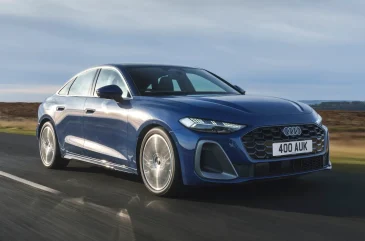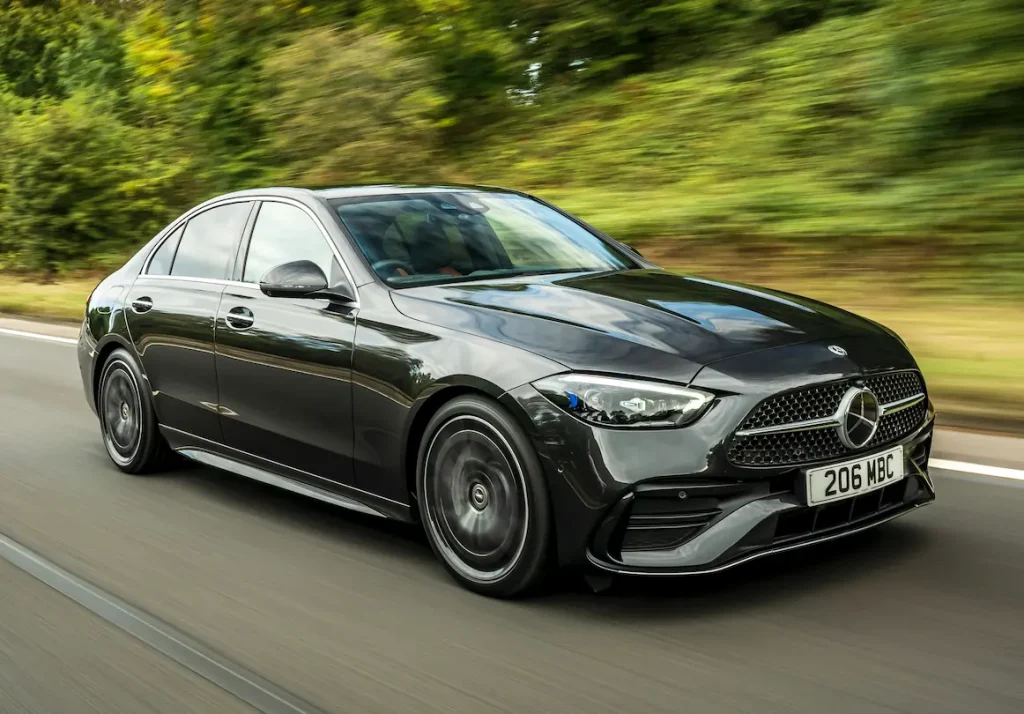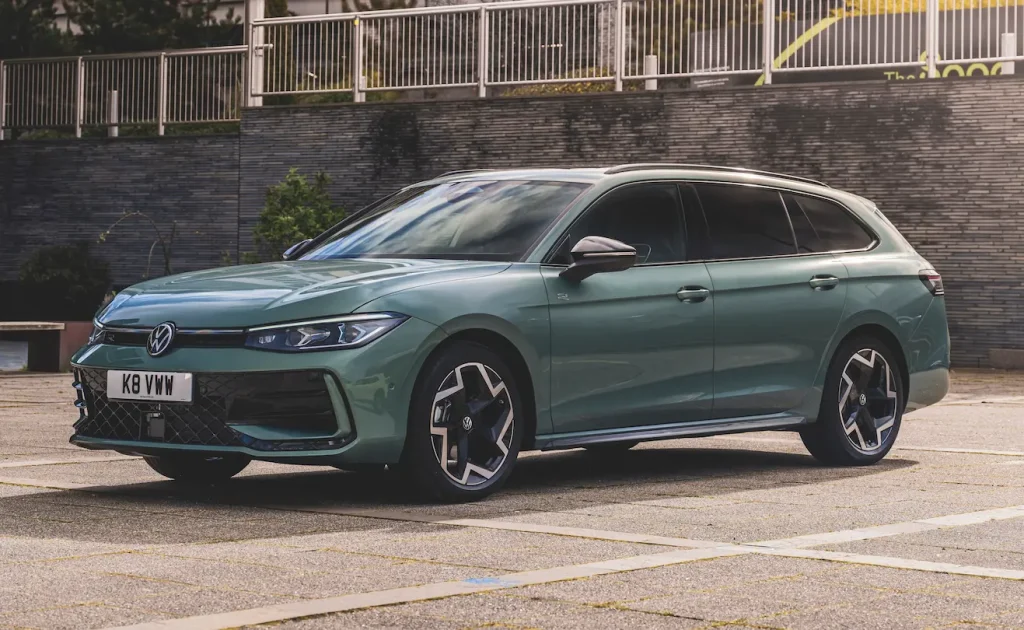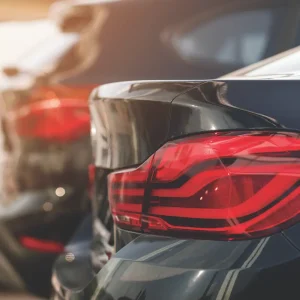
Audi A5
In the biggest shake-up of Audi nomenclature in 30 years, the A4/S4 becomes the A5/S5, with the new A5/S5 also replacing the previous A5 Coupe and Sportback ranges. Audi’s rationale for the change when the model came out was that all ICE models would have odd numbers, with the evens reserved for EVs – although this policy has since been axed.
Outside, the look of the A5 is more evolutionary, although the flared arches, flatter single-frame grille, unusual flush door handles, and s changeable front and rear light signatures give a subtly different look. The A5 Saloon, confusingly, is a hatchback, like previous Sportback versions.
Underneath, the A5/S5 is the first model to use Audi’s Premium Platform Combustion (PPC) architecture. As a result, the new A5/S5 is 67mm longer, 13mm wider, and 24mm taller – moving it closer to the bigger A6.
Following the Q6 E-Tron, the new A5/S5 is the second example of Audi’s new interior design. The highlight again is the dashboard, with its slim, curved panoramic display, incorporating an 11.9in Audi virtual cockpit and a 14.5in MMI touchscreen. Space in the front and the driving position are good, although it’s more compromised in the back – especially if you go for the Saloon we have here. Rear legroom at best is average, and the Saloon’s curvier roofline eats into headroom, meaning the tallest heads will be brushing the roof.
The new A5/S5 range is powered by three petrol and one TDI diesel engines. There are two 2.0-litre TFSI petrol engines, with 150hp and 204hp, and the 367hp 3.0-litre V6 TFSI in the S5. Plus, a 204PS, 2.0-litre TDI diesel. All the petrol models benefit from 48V mild-hybrid technology. Choose the diesel, and it’s partially electrified – being able to run short distances on electric power alone, thanks to the MHEV Plus system.
The A5 Saloon we’re highlighting here is powered by what Audi expects to be the most popular engine in the UK, the 150hp, 2.0-litre petrol. This TFSI version has 280Nm of torque, and acceleration to 62mph in 9.8 seconds, making it an adequate performer.
The entry-level Edition spec might be more affordable, but previous experience tells us the S Line spec we’ve featured here will sell better to fleet drivers.
Despite, the lowest MPG and highest SMR figure, the Audi comes first in this set. This is due to its impressively low depreciation, and also the second-lowest P11D value.
Read more: Audi A5/S5 review
| Model | Audi A5 2.0 150PS S Line |
| P11D | £43,365 |
| CO2 (tax) | 154g/km (35%) |
| BIK 20/40% a month | £253/£506 |
| Fuel consumption | 41.5mpg |
| National Insurance | £209 |
| First year VED | £680 |
| Subsequent VED | £190 |
| Engine size/power | 1,984cc + mild hybrid/150hp |
| AFR | 14p |
| Residual value | 57% |
| Depreciation | £18,847 |
| Fuel costs | £7,415 |
| SMR | £3,705 |
| Cost per mile | 49.94p |

BMW 3 Series
Both the new A5 and C-Class run it close, but even in 320 form, the seventh-generation BMW remains king of the small executive class, cost per mile aside, and previously won Best Premium Car at the Business Car Awards, until its EV sister, the i4, took over last year. Why? Well, it’s great to drive, and is affordable to run.
Inside, the most distinctive feature is the large, curved display that is made up of a 14.9in infotainment touchscreen and 12.3in driver display. Although legroom in the back of the 3 Series is more compromised, but this BMW does have a 480-litre boot.
Even in M Sport specification, the 3 Series is the cheapest to buy of our group. The BMW also has the second-lowest depreciation figure at £21,429, and the joint lowest fuel cost figure. Being so competitive in so many areas, it’s not surprising that the BMW comes a close second to the Audi overall.
| Model | BMW 320i M Sport |
| P11D | £41,145 |
| CO2 (tax) | 148g/km (34%) |
| BIK 20/40% a month | £233/£466 |
| Fuel consumption | 43.5mpg |
| National Insurance | £193 |
| First year VED | £270 |
| Subsequent VED | £190 |
| Engine size/power | 1,998cc+ mild hybrid/182hp |
| AFR | 14p |
| Residual value | 48% |
| Depreciation | £21,429 |
| Fuel costs | £7,075 |
| SMR | £3,142 |
| Cost per mile | 52.74p |

Mercedes-Benz C-Class
Outside and inside, the current C-Class feels every bit the scaled-down S-Class. This is no bad thing, as both are well-designed – although when you look closer at this Mercedes’ interior trim, it’s not as special as you’d expect, considering the three-star badge.
The main C-Class fleet interest points are the plug-in hybrids, but we’ve got the entry-level mild hybrid petrol, which allows the C200 to coast with the engine off, plus gives a small power boost when overtaking.
Despite comparable fuel economy and emissions to the other models in this set, the C-Class is safe rather than being that much fun to drive, like for example the Audi and BMW.
The Mercedes has the joint lowest fuel cost figure here with the BMW, at £7,075. However, relatively high depreciation, at £25,184, along with the second-highest SMR figure, at £3,146, mean it’s unable to do better than third place overall in this comparison.
Read more: Mercedes-Benz C-Class review
| Model | Mercedes-Benz C200 AMG Line |
| P11D | £44,805 |
| CO2 (tax) | 142g/km (33%) |
| BIK 20/40% a month | £246/£492 |
| Fuel consumption | 44.1mpg |
| National Insurance | £204 |
| First year VED | £270 |
| Subsequent VED | £190 |
| Engine size/power | 1,993cc + mild hybrid/225hp |
| AFR | 14p |
| Residual value | 44% |
| Depreciation | £25,184 |
| Fuel costs | £7,075 |
| SMR | £3,146 |
| Cost per mile | 59.00p |

Volkswagen Passat
The all-new ninth-generation Passat was launched last year as an estate only – making an odd comparison with the new A5 Saloon, that is itself actually a hatchback!
We’ve got the sportiest looking R-Line spec for comparison, but to keep the price comparable, we’ve had to go for the small 1.5 eTSI petrol engine – although it’s still more powerful than the Audi!
With the sporty ‘R’ makeover, the Passat looks sharp and purposeful.Inside, the result of the wheelbase growing by 50 millimetres in length is an impressively spacious interior, along with a massive 690-litre estate boot!
Of the cars we’re considering here, the Volkswagen has the cheapest expected SMR costs. However, perhaps due to a less premium badge than the other three, it has the weakest expected residual values. This is the main reason for it bringing up the rear overall in this comparison.
Read more: Volkswagen Passat review
| Model | Volkswagen Passat 1.5 TSIe R-Line |
| P11D | £43,690 |
| CO2 (tax) | 129g/km (30%) |
| BIK 20/40% a month | £218/£437 |
| Fuel consumption | 42.2mpg |
| National Insurance | £180 |
| First year VED | £220 |
| Subsequent VED | £190 |
| Engine size/power | 1,498cc + mild hybrid/148hp |
| AFR | 14p |
| Residual value | 40% |
| Depreciation | £26,435 |
| Fuel costs | £7,415 |
| SMR | £2,858 |
| Cost per mile | 61.18p |





